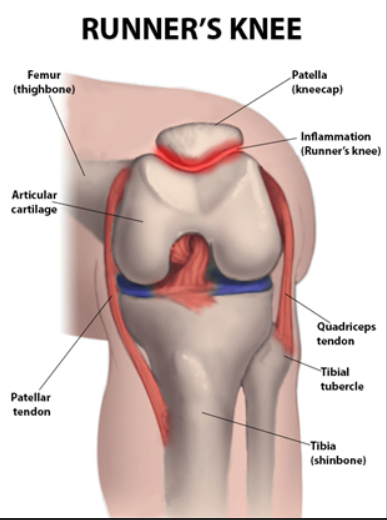By Marie Serrado
Runner’s Knee, also known as Patellofemoral Pain Syndrome (PFPS) is knee pain associated with your kneecap or patella. It’s most common when you are a runner. Runner’s knee pain can be dull or sharp and even severe depending on the intensity of the exercise. The persistent pain and discomfort in the knee, often accompanied by stiffness and swelling, can quickly put a damper on your training routine. But fear not, for there is hope on the horizon. Whether you’re a seasoned marathon runner or just getting started on your fitness journey, this guide will empower you with the knowledge and strategies needed to overcome runner’s knee and get back on the track, trail, or treadmill stronger than ever before.
What Causes Runner’s Knee
When it comes to runner’s knee there are many factors that can be the cause. Several factors that one must take that can contribute to this is:
-
-
- Overuse: When you are overusing your legs, whether that is through excessive exercising such as: lunges and plyometrics ( which involves training the way your muscles work in order to gain a boost of power.) or even lifting and bending, those movements can create tissue issues around or in the kneecap.
- Direct hit to the knee: Such as a Fall or Blow
- Problems with your feet: Such as ;
-
- Hypermobile feet– which occurs when the joints in and around them move more than they should.
- Fallen Achilles– also known as flat feet.
- Overpronation-which occurs when your foot rolls down and inward when you step. This can create problems in your feet which will affect your knees.
-
- Weak thigh muscles: When one has weak thigh muscles, problems can occur. With weak thigh muscles, the quadriceps help keep your kneecap in place when you bend or stretch the joint, if you develop weak thigh muscles then your kneecap may not stay in the right place.
- Chondromalacia Patella: a condition in which the cartilage under your kneecap breaks down.
-
What are the symptoms of Runner’s Knee:
Runner’s knee is characterized by a range of symptoms centered around discomfort and pain in the front of the knee. Always talk with your healthcare provider if you are experiencing these symptoms . Individuals with runner’s knee typically experience:
-
-
- Pain in or around the kneecap when you are active. Although sometimes it can also be around or behind the knee.
- Pain after sitting for a long period of time with the knees bent.
- Kneecap that is tender to touch.
- Rubbing, grinding, or even clicking sounds that you feel or hear when you are bending or straightening your knee.
-
How can Physical Therapy help?
When dealing with a runner’s knee, physical therapy can be the most effective method to help treat the problem. With physical therapy, your physical therapist can help create a treatment plan that will work best for your pain-related issue. After a comprehensive evaluation and if PFPS is present, your physical therapist will analyze the findings and begin to prescribe rehabilitation and exercise treatments designed just for you. Our Physical Therapist at Strive! Health and Rehabilitation can help with assisting you in learning techniques to help alleviate the pain along with carrying and improving a better quality of life. Your physical therapists can help with:
-
-
- Strengthening Exercise
- Stretching Exercises
- Fitting for orthotics
- Bracing or taping
- And more!
-
In conclusion:
Runner’s Knee, also known as Patellofemoral Pain Syndrome (PFPS), can be a challenging condition for runners and active individuals. It often involves pain and discomfort around the kneecap, which can be caused by various factors such as overuse, direct knee trauma, foot issues, weak thigh muscles, or cartilage breakdown. However, there is hope for overcoming this condition, and physical therapy plays a crucial role in the recovery process. It’s essential to work closely with your healthcare provider and physical therapist to create a personalized treatment plan that addresses your specific condition and needs. Consistency in following the prescribed exercises and lifestyle modifications is key to a successful recovery.
References:
-
-
- How can physical therapy help runner’s knee? (fast and easy guide). Raleigh Orthopaedic. (2019, January 11). https://www.raleighortho.com/blog/sports-medicine/how-can-physical-therapy-help-runners-knee-fast-and-easy-guide/
- Joseph , T. N., Turley, R., & Wojcik, S. (Eds.). (n.d.). Runner’s Knee. Cedars. https://www.cedars-sinai.org/health-library/diseases-and-conditions/r/runners-knee.html
- Patellofemoral pain syndrome (Runner’s knee). Johns Hopkins Medicine. (2023a, March 3). https://www.hopkinsmedicine.org/health/conditions-and-diseases/patellofemoral-pain-syndrome-runners-knee
-





